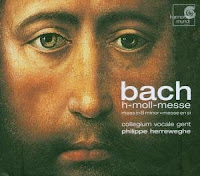
Johann Sebastian Bach
"Mass in B Minor"
Harmonia Mundi (1998)
1000 Recordings to Hear Before You Die
As a Catholic, I can say with some authority that the more shallow members of the faith (aka: most of us) appreciate a short ceremony. They would've been out of luck during Bach's day. The average mass lasted more than two hours. The good news is that, if it was anything like the composer's Mass in B Minor, the music was excellent.
Mass in B, the last of the four Bach pieces that this blog will examine, was drafted by Bach to encompass every aspect of the Catholic mass (this in itself is ironic, considering that Bach was a Lutheran). The piece is comprised of five sections that align with the mass (modern equivalents in parentheses): Kyrie ("Lord have mercy"), Gloria, Credo (Nicene Creed), and a compilation consisting of Sanctus, Hosanna, Benedictus and Agnus Dei. If heard in English, a Catholic will be able to trace the progression of the Mass based on the lyrics.
Something worth clarifying is the overall mood of this piece. It's easy to understand why someone might initially presume this to be a downer; The "minor" indicates the minor key, scales that create a "sad" tone. "In B Minor" is a misleading title however, one that was not assigned by Bach. Untitled, the collection was dubbed "in B Minor" because its opening movement, "Kirie Eleison," is in B Minor. If a key-based title were to be given, "Mass in D Major" would have been more accurate. There are ten movements in D Major, as opposed to five in B Minor.
Despite the two-plus hour listen, there is an incredible degree of variety from movement to movement, which makes it easy to pay attention. The variety of keys has already been mentioned, but the variety in vocal approaches helps even more. There are five-part, four-part, and solo arias, each in a variety of keys. Moon rightly applauds the Collegium Vocale of Ghent for its 23-voice approach. A choir of 120 (as seen with the Abyssinian Baptist Church) would not allow appreciation for the subtle intonation artfully present in Bach's layout. The diversity applies to the instrumentals as well; The music stretches from typical Baroque chamber orchestras to solo (obbligato) instruments, including the violin and oboe.
Variety is a popular theme in this entry, but it is even more important as an overriding theme to the four entries for Bach. We have seen full-out concertos, solo works for violin and piano, and a religious composition designed primarily for vocalists. The ability to work in so many forms is a testament to his genius, reputation in the Baroque era, and his overall influence on modern music.
INTERESTING FACT: Although Mass in B Minor is of course, a mass, its first performance was not at mass at all, but rather at King Augustus III of Poland's Oath of Allegiance festival, following his rise to the throne.
No comments:
Post a Comment